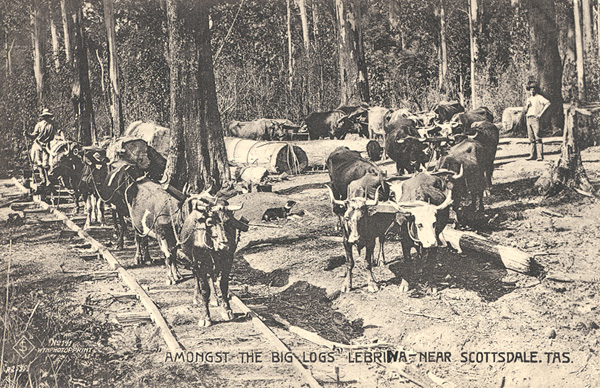 |
 |
|
Forestry
Tasmania's forests mightily impressed early European visitors; one reason for settlement was to secure another place for procuring timber for the British navy. Shipbuilding did develop, along with other forest-based industries, but farmers and pastoralists were the first important users of forested land. The cultural landscapes created by thousands of years of use and management by burning by Aboriginal people were taken over by pastoralists. Clearing of the taller forest with a dense understorey on more fertile soils began in earnest in the mid-nineteenth century in response to land laws from 1851 which encouraged the purchase of forested Crown land. Significant areas were alienated, but much was not cleared. Tasmania has a high proportion of privately owned forests, about 30 percent by area, which was formally recognised by the government when the Private Forests Council was established in 1978. A government authority, Private Forests Tasmania, was formed in 1994, to provide assistance and advice on private forest management. Forest-based industries expanded greatly in the mid-nineteenth century, supplying timber to Melbourne, the Victorian goldfields and overseas. To further encourage economic development, legislation of 1898 gave resource security through guaranteed access to timber in return for capital investment in processing plants. The concession system was thereby inaugurated. Payments for the quantity of logs taken from Crown forests – royalties – were introduced in the same year, supplementing licence fees. The first concessions were for timber milling in the Southern Forests. They were followed by five more, set up by Acts of Parliament from 1926 to 1968, primarily designed to encourage papermaking. Paper mills were built at Burnie, Boyer and Wesley Vale, and a pulp mill at Geeveston, while exports of pulpwood as woodchips began in 1972. An attempt to use export woodchips in a new pulp mill at Wesley Vale failed in 1989, following an environmental campaign. The concession acts were ended in the 1990s, resource security, better financial returns, and flexibility in forest management being provided by contracts. Provisions for management of public forest began in the last part of the nineteenth century. Powers to set aside Crown land for timber purposes came in 1881, and to appoint a conservator of forest in 1885. The post was rarely filled until Llewellyn Irby was appointed in 1919. He fathered the Forestry Act (1920), setting up a forestry department, which gave real impetus to management, the goal being sustainable yield management based on scientific understanding of forests protected from fire, uncontrolled logging and alienation for agriculture. Progress was further helped when the Forestry Commission was established in 1947, following a Royal Commission into Forestry Administration, which highlighted improper dealings in land and timber by politicians and officials. The Forestry Commission organised an assessment of the quantity of forests and their sustained yield, and made necessary reductions in sawlog harvests. Techniques for the systematic regeneration of logged forests, were introduced, replacing 'log-it-and-leave-it'. Significant changes at the end of the twentieth century encompassed commercialism, implementation of a forest practices system and large changes in allocations of Crown land, as part of the environmental revolution, which led to aspects of forest management becoming controversial. Increased areas were set aside as reserves and, for a period, the Commonwealth directly intervened in forest management by the states, the licensing of exports of woodchips in 1986 being a key instrument for intervention. The Commonwealth instituted a series of inquiries, and a series of negotiations between state and federal governments followed. In Tasmania, further areas were transferred to reserves, with consequent reductions in the annual harvest of sawlogs, and the Commonwealth made capital available as partial compensation for the production foregone. Much of this capital was used for additional plantations, which have become a valuable source of wealth since their initiation by Irby. Finally, the Commonwealth implemented an exit strategy, the regional forest agreement process, balancing preservation and production. A Tasmanian Regional Forest Agreement was signed in 1997. As part of a general requirement for government agencies to take an increasingly commercial approach, the Commission was replaced in 1994 by a government business enterprise, Forestry Tasmania, with a statutory duty to optimise both economic returns and benefits from non-wood values. Formal discussions on a forest practices system began in 1979; the Act dates from 1985 and requires a Forest Practices Code, the first dating from 1987. The Code applies to private as well as public forests, provides a practical set of guidelines and standards for the protection of environmental values during forest operations and is a key measure in the continuing journey towards sustainable development. Further reading: L Carron, A history of forestry in Australia, Canberra, 1985; J Dargavel, Fashioning Australia's forests, Melbourne, 1995. Ken Felton |
Copyright 2006, Centre for Tasmanian Historical Studies |
